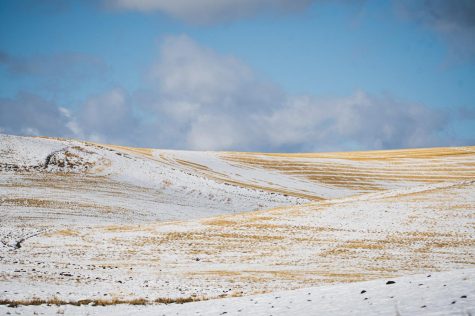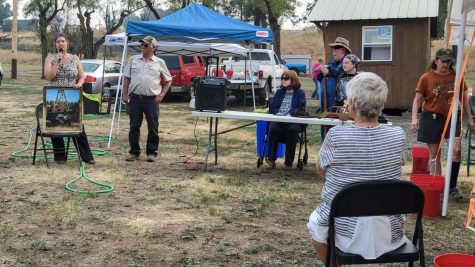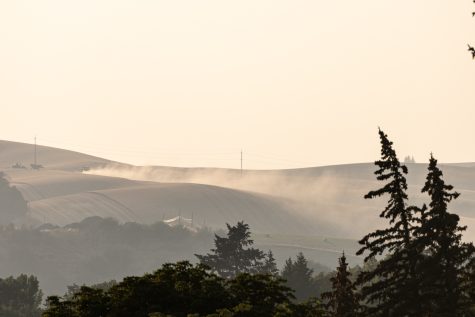‘It’s always a Monarch’
Number of Monarchs has dropped from 250,000 to 25,000 which is a 90 percent decrease in the population
Monarch butterflies are tagged by scientists in order to be tracked, said David James, associate professor at WSU Prosser’s Irrigated Agriculture Research and Extension Center.
Public citizens flutter and swarm to help WSU scientists discover the migration path of Western Monarchs between the months of February and May.
The community-science project “The Western Monarch Mystery Challenge” began Feb. 14 and will continue until April 22.
Due to the unknown migration patterns of Monarchs, every-day residents are capturing footage of the butterflies for the challenge.
David James, associate professor at WSU Prosser’s Irrigated Agriculture Research and Extension Center, said migrating populations in the western U.S. have declined more than 90 percent from 2018 to 2019. Populations have been low relative to historical population sizes, but relatively stable until 2018. This is when the number of Monarchs dropped from 250,000 to 25,000.
He said Monarchs are known as “the world’s butterfly.” A Monarchs’ image is ingrained in public thought and has helped create public interest in protecting the species, he said.
“If you see a butterfly in a children’s book, it’s always a Monarch,” he said.
Researching where Monarchs migrate after overwintering in California is critical to understanding their broad habitat needs, he said.
The challenge allows residents to use technology such as phone cameras and science-apps like iNaturalist to help gather data.
By finding out where Monarchs migrate and why they stay there, scientists can identify why those areas are important. This will allow scientists to preserve those areas.
Using the public to gather data has helped scientists in the past, he said.
“We started in 2012, with the question of ‘What do Western Monarchs do in terms of migration?’” he said. “We suspected they flew to California for winter but no one has actually proven that — no tagging program in this part of the country.”
Tagging is the act of putting a tracker on a butterfly.
“We assume they’re in California, somewhere,” James said. “The numbers are just so low.”
James’ research team created a program which enlists inmates from the Washington State Penitentiary (WSP) to increase the number of people watching for Monarchs.
The Monarch tagging program at WSP is an example of non-professional scientists helping research.
Overall, about 200 people are assisting in James’ program. The people involved live throughout the Pacific Northwest including Oregon, Washington and Idaho.
James said he takes a trip with his family to Trinity National Forest in California every year. While there, he said he counts Monarchs flying North over the river. He said he has seen as many as 110 Monarchs.
This past year’s trip was the first time since 2012 James and his family could not spot a single Monarch.
“We were there last year, and for the first time … not a single one,” he said.
Robert Coffan, co-founder and chair of the advocacy group Western Monarch Advocates, said population drops are not exclusive to Monarchs, but have also affected other pollinators such as honeybees.
“Twenty-five thousand Western Monarchs left, that’s less than the number of honeybees in one healthy beehive,” he said. “That’s representing our entire Western Monarch population now. ”
He said increasingly impactful winter storms, specifically the wind and rain, are likely the cause of Monarch mortality.
Cofffan said his memories of Monarchs inspired his passion for the species.
“Go back and think about the first time you got the aha-moment — with the monarch butterfly — was it when you’re with your grandma, where she’s pointing it out?” he said. “Was it a hot day and you saw the wings open for the first time and saw that bright orange just pop?”
James said Monarchs are connected to the Palouse. This region has been part of the migration route, and Monarchs were spotted yearly by local observers. However, in the last two years, Monarchs have all but disappeared not only from the Palouse, but from all of Washington State.
There have only been eight Monarch sightings in all of Washington State last year. This coincides with the declines seen in the west.
“Normally, hundreds every year get reported to me,” he said.
James said planting milkweed in backyards will attract Monarchs. Milkweeds are the exclusive host plant of Monarch caterpillars and are critical to the survival of the butterfly and their life-cycle.
It is currently unknown how the butterflies locate milkweed, but the butterflies are able to find the flower from large distances.
People involved in James’ program will report their sightings to him and he will mail them tags which are then used to track Monarchs.
TJ is a marine biology PhD student. He is from Cartersville, Georgia.

















